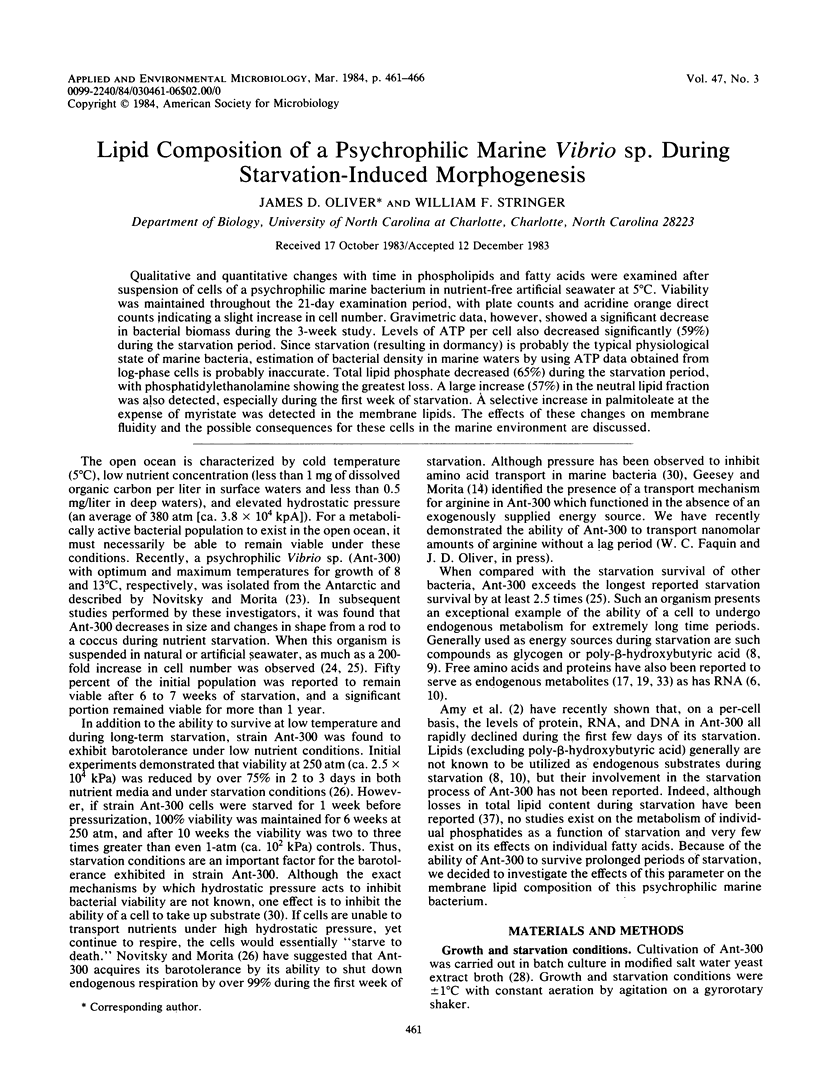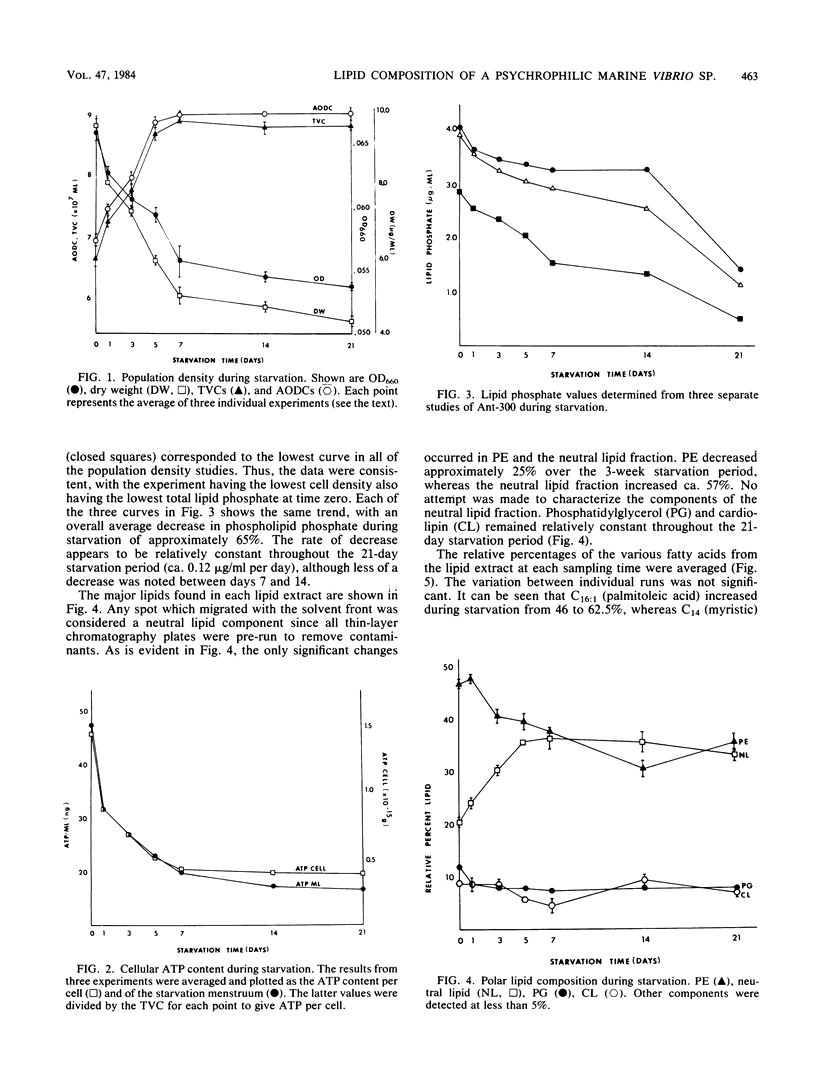Abstract
Qualitative and quantitative changes with time in phospholipids and fatty acids were examined after suspension of cells of a psychrophilic marine bacterium in nutrient-free artificial seawater at 5°C. Viability was maintained throughout the 21-day examination period, with plate counts and acridine orange direct counts indicating a slight increase in cell number. Gravimetric data, however, showed a significant decrease in bacterial biomass during the 3-week study. Levels of ATP per cell also decreased significantly (59%) during the starvation period. Since starvation (resulting in dormancy) is probably the typical physiological state of marine bacteria, estimation of bacterial density in marine waters by using ATP data obtained from log-phase cells is probably inaccurate. Total lipid phosphate decreased (65%) during the starvation period, with phosphatidylethanolamine showing the greatest loss. A large increase (57%) in the neutral lipid fraction was also detected, especially during the first week of starvation. A selective increase in palmitoleate at the expense of myristate was detected in the membrane lipids. The effects of these changes on membrane fluidity and the possible consequences for these cells in the marine environment are discussed.
Full text
PDF





Selected References
These references are in PubMed. This may not be the complete list of references from this article.
- AMES B. N., DUBIN D. T. The role of polyamines in the neutralization of bacteriophage deoxyribonucleic acid. J Biol Chem. 1960 Mar;235:769–775. [PubMed] [Google Scholar]
- Amy P. S., Pauling C., Morita R. Y. Starvation-survival processes of a marine Vibrio. Appl Environ Microbiol. 1983 Mar;45(3):1041–1048. doi: 10.1128/aem.45.3.1041-1048.1983. [DOI] [PMC free article] [PubMed] [Google Scholar]
- BLIGH E. G., DYER W. J. A rapid method of total lipid extraction and purification. Can J Biochem Physiol. 1959 Aug;37(8):911–917. doi: 10.1139/o59-099. [DOI] [PubMed] [Google Scholar]
- Beuchat L. R., Worthington R. E. Relationships between heat resistance and phospholipid fatty acid composition of Vibrio parahaemolyticus. Appl Environ Microbiol. 1976 Mar;31(3):389–394. doi: 10.1128/aem.31.3.389-394.1976. [DOI] [PMC free article] [PubMed] [Google Scholar]
- Bhakoo M., Herbert R. A. Fatty acid and phospholipid composition of five psychrotrophic Pseudomonas spp. grown at different temperatures. Arch Microbiol. 1980 May;126(1):51–55. doi: 10.1007/BF00421890. [DOI] [PubMed] [Google Scholar]
- Cronan J. E., Jr, Gelmann E. P. Physical properties of membrane lipids: biological relevance and regulation. Bacteriol Rev. 1975 Sep;39(3):232–256. doi: 10.1128/br.39.3.232-256.1975. [DOI] [PMC free article] [PubMed] [Google Scholar]
- DAWES E. A., RIBBONS D. W. SOME ASPECTS OF THE ENDOGENOUS METABOLISM OF BACTERIA. Bacteriol Rev. 1964 Jun;28:126–149. doi: 10.1128/br.28.2.126-149.1964. [DOI] [PMC free article] [PubMed] [Google Scholar]
- DAWES E. A., RIBBONS D. W. STUDIES ON THE ENDOGENOUS METABOLISM OF ESCHERICHIA COLI. Biochem J. 1965 May;95:332–343. doi: 10.1042/bj0950332. [DOI] [PMC free article] [PubMed] [Google Scholar]
- DAWES E. A., RIBBONS D. W. The endogenous metabolism of microorganisms. Annu Rev Microbiol. 1962;16:241–264. doi: 10.1146/annurev.mi.16.100162.001325. [DOI] [PubMed] [Google Scholar]
- De Siervo A. J. Alterations in the phospholipid composition of Escherichia coli B during growth at different temperatures. J Bacteriol. 1969 Dec;100(3):1342–1349. doi: 10.1128/jb.100.3.1342-1349.1969. [DOI] [PMC free article] [PubMed] [Google Scholar]
- Ensign J. C. Long-term starvation survival of rod and spherical cells of Arthrobacter crystallopoietes. J Bacteriol. 1970 Sep;103(3):569–577. doi: 10.1128/jb.103.3.569-577.1970. [DOI] [PMC free article] [PubMed] [Google Scholar]
- Geesey G. G., Morita R. Y. Capture of arginine at low concentrations by a marine psychrophilic bacterium. Appl Environ Microbiol. 1979 Dec;38(6):1092–1097. doi: 10.1128/aem.38.6.1092-1097.1979. [DOI] [PMC free article] [PubMed] [Google Scholar]
- Geesey G. G., Morita R. Y. Relationship of cell envelope stability to substrate capture in a marine psychrophilic bacterium. Appl Environ Microbiol. 1981 Sep;42(3):533–540. doi: 10.1128/aem.42.3.533-540.1981. [DOI] [PMC free article] [PubMed] [Google Scholar]
- Harwood C. S., Canale-Parola E. Branched-chain amino acid fermentation by a marine spirochete: strategy for starvation survival. J Bacteriol. 1981 Oct;148(1):109–116. doi: 10.1128/jb.148.1.109-116.1981. [DOI] [PMC free article] [PubMed] [Google Scholar]
- Lofgren K. W., Fox C. F. Attractant-directed motility in Escherichia coli: requirement for a fluid lipid phase. J Bacteriol. 1974 Jun;118(3):1181–1182. doi: 10.1128/jb.118.3.1181-1182.1974. [DOI] [PMC free article] [PubMed] [Google Scholar]
- MORRISON W. R., SMITH L. M. PREPARATION OF FATTY ACID METHYL ESTERS AND DIMETHYLACETALS FROM LIPIDS WITH BORON FLUORIDE--METHANOL. J Lipid Res. 1964 Oct;5:600–608. [PubMed] [Google Scholar]
- Novitsky J. A., Morita R. Y. Morphological characterization of small cells resulting from nutrient starvation of a psychrophilic marine vibrio. Appl Environ Microbiol. 1976 Oct;32(4):617–622. doi: 10.1128/aem.32.4.617-622.1976. [DOI] [PMC free article] [PubMed] [Google Scholar]
- Novitsky J. A., Morita R. Y. Survival of a psychrophilic marine Vibrio under long-term nutrient starvation. Appl Environ Microbiol. 1977 Mar;33(3):635–641. doi: 10.1128/aem.33.3.635-641.1977. [DOI] [PMC free article] [PubMed] [Google Scholar]
- Okuyama H. Phospholipid metabolism in Escherichia coli after a shift in temperature. Biochim Biophys Acta. 1969 Jan 21;176(1):125–134. [PubMed] [Google Scholar]
- Oliver J. D., Colwell R. R. Extractable lipids of gram-negative marine bacteria: phospholipid composition. J Bacteriol. 1973 Jun;114(3):897–908. doi: 10.1128/jb.114.3.897-908.1973. [DOI] [PMC free article] [PubMed] [Google Scholar]
- Paul K. L., Morita R. Y. Effects of hydrostatic pressure and temperature on the uptake and respiration of amino acids by a facultatively psychrophilic marine bacterium. J Bacteriol. 1971 Nov;108(2):835–843. doi: 10.1128/jb.108.2.835-843.1971. [DOI] [PMC free article] [PubMed] [Google Scholar]
- Pluschke G., Overath P. Function of phospholipids in Escherichia coli. Influence of changes in polar head group composition on the lipid phase transition and characterization of a mutant containing only saturated phospholipid acyl chains. J Biol Chem. 1981 Apr 10;256(7):3207–3212. [PubMed] [Google Scholar]
- Randle C. L., Albro P. W., Dittmer J. C. The phosphoglyceride composition of Gram-negative bacteria and the changes in composition during growth. Biochim Biophys Acta. 1969;187(2):214–220. doi: 10.1016/0005-2760(69)90030-7. [DOI] [PubMed] [Google Scholar]
- Russell N. J. The lipid composition of the psychrophilic bacterium Micrococcus cryophilus. J Gen Microbiol. 1974 Jan;80(1):217–225. doi: 10.1099/00221287-80-1-217. [DOI] [PubMed] [Google Scholar]
- Shand J. H., Noble R. C. Quantification of lipid mass by a liquid scintillation counting procedure following charring on thin-layer plates. Anal Biochem. 1980 Jan 15;101(2):427–434. doi: 10.1016/0003-2697(80)90209-2. [DOI] [PubMed] [Google Scholar]
- Thomas T. D., Batt R. D. Degradation of cell constituents by starved Streptococcus lactis in relation to survival. J Gen Microbiol. 1969 Nov;58(3):347–362. doi: 10.1099/00221287-58-3-347. [DOI] [PubMed] [Google Scholar]
- Watson S. W., Novitsky T. J., Quinby H. L., Valois F. W. Determination of bacterial number and biomass in the marine environment. Appl Environ Microbiol. 1977 Apr;33(4):940–946. doi: 10.1128/aem.33.4.940-946.1977. [DOI] [PMC free article] [PubMed] [Google Scholar]
- West P. A., Lee J. V., Bryant T. N. A numerical taxonomic study of species of Vibrio isolated from the aquatic environment and birds in Kent, England. J Appl Bacteriol. 1983 Oct;55(2):263–282. doi: 10.1111/j.1365-2672.1983.tb01324.x. [DOI] [PubMed] [Google Scholar]


